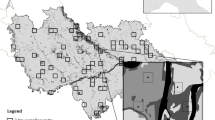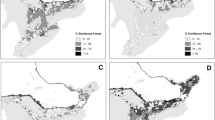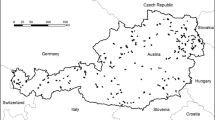Abstract
Context
Biodiversity in tropical region has declined in the last decades, mainly due to forest conversion into agricultural areas. Consequently, species occupancy in these landscapes is strongly governed by environmental changes acting at multiple spatial scales.
Objectives
We investigated which environmental predictors best determines the occupancy probability of 68 bird species exhibiting different ecological traits in forest patches.
Methods.
We conducted point-count bird surveys in 40 forest sites of the Brazilian Atlantic forest. Using six variables related to landscape composition and configuration and local vegetation structure, we predicted the occupancy probability of each species accounting for imperfect detections.
Results
Landscape composition, especially forest cover, best predicted bird occupancy probability. Specifically, most bird species showed greater occupancy probability in sites inserted in more forested landscapes, while some species presented higher occurrence in patches surrounded by low-quality matrices. Conversely, only three species showed greater occupancy in landscapes with higher number of patches and dominated by forest edges. Also, several species exhibited greater occupancy in sites harbouring either larger trees or lower number of understory plants. Of uttermost importance, our study revealed that a minimum of 54% of forest cover is required to ensure high (> 60%) occupancy probability of forest species.
Conclusions
We highlighted that maintaining only 20% of native vegetation in private property according to Brazilian environmental law is insufficient to guarantee a greater occupancy for most bird species. We recommend that policy actions should safeguard existing forest remnants, expand restoration projects, and curb human-induced disturbances to minimise degradation within forest patches.


Similar content being viewed by others
References
Alldredge MW, Simons TR, Pollock KH (2007) Factors affecting aural detections of songbirds. Ecol Appl 17(3):948–955
Antongiovanni M, Metzger JP (2005) Influence of matrix habitats on the occurrence of insectivorous bird species in Amazonian forest fragments. Biol Conserv 122(3):441–451
Arroyo-Rodríguez V, Fahrig L, Tabarelli M, Watling JI, Tischendorf L, Benchimol M, Melo FPL, Morante-Filho JC, Santos BA, Arasa-Gisbert R, Arce-Peña N, Cervantes-López MJ, Cudney-Valenzuela S, Galan-Acedo C, San-José M, Vieira IMG, Slik JWF, Nowakowski J, Tscharntke T (2020) Designing optimal human-modified landscapes for forest biodiversity conservation. Ecol Lett 23:1404–1420
Banks-Leite C, Ewers RM, Metzger JP (2013) The confounded effects of habitat disturbance at the local, patch and landscape scale on understorey birds of the Atlantic Forest: implications for the development of landscape-based indicators. Ecol indic 31:82–88
Barlow J, Lennox GD, Ferreira J, Berenguer E, Lees AC, Nally RM, Thomson JR, Ferraz SFB, Louzada J, Oliveira VHF, Parry L, Solar RRC, Vieira ICG, Aragão LEOC, Begotti RA, Braga RF, Cardoso TM, Oliveira RC Jr, Souza CM Jr, Moura NG, Nunes SS, Siqueira JV, Pardini R, Silveira JM, Vaz-de-Mello FZ, Veiga RCS, Venturieri A, Gardner TA (2016) Anthropogenic disturbance in tropical forests can double biodiversity loss from deforestation. Nature 535(7610):144–147
Benchimol M, Peres CA (2014) Predicting primate local extinctions within “real-world” forest fragments: a pan-neotropical analysis. Am J Primatol 76(3):289–302
Benchimol M, Peres CA (2015) Predicting local extinctions of Amazonian vertebrates in forest islands created by a mega dam. Biol Conserv 187:61–72
Benchimol M, Mariano-Neto E, Faria D, Rocha-Santos L, Pessoa MS, Gomes FS, Custodio D, Cazetta E (2017) Translating plant community responses to habitat loss into conservation practices: forest cover matters. Biol Conserv 209:499–507
Bhakti T, Goulart F, de Azevedo CS, Antonini Y (2018) Does scale matter? The influence of three-level spatial scales on forest bird occurrence in a tropical landscape. PLoS ONE 13(6):e0198732
Boron V, Deere NJ, Xofis P, Link A, Quiñones-Guerrero A, Payan E, Tzanopoulos J (2019) Richness, diversity, and factors influencing occupancy of mammal communities across human-modified landscapes in Colombia. Biol Conserv 232:108–116
Boscolo D, Metzger JP (2009) Is bird incidence in Atlantic forest fragments influenced by landscape patterns at multiple scales? Landsc Ecol 24(7):907–918
Bregman TP, Şekercioḡlu CH, Tobias JA (2014) Global patterns and predictors of bird species responses to forest fragmentation: implications for ecosystem function and conservation. Biol Conserv 169:372–383
Brinkmann N, Schneider D, Sahner J, Ballauff J, Edy N, Barus H, Bambang I, Budi SW, Qaim M, Daniel R, Polle A (2019) Intensive tropical land use massively shifts soil fungal communities. Sci Rep 9(1):1–11
Burnham KP, Anderson DR (2002) Model selection and multimodel inference: a practical information-theoretic approach. Springer, New York
Curtis PG, Slay CM, Harris NL, Tyukavina A, Hansen MC (2018) Classifying drivers of global forest loss. Science 361(6407):1108–1111
Da Silveira NS, Niebuhr BBS, de Lara MR, Ribeiro MC, Pizo MA (2016) Effects of land cover on the movement of frugivorous birds in a heterogeneous landscape. PLoS ONE 11(6):e0156688
Donoso I, Sorensen MC, Blendinger PG, Kissling WD, Neuschulz EL, Mueller T, Schleuning M (2020) Downsizing of animal communities triggers stronger functional than structural decay in seed-dispersal networks. Nat Commun 11(1):1–8
Edwards DP, Socolar JB, Mills SC, Burivalova Z, Koh LP, Wilcove DS (2019) Conservation of tropical forests in the anthropocene. Curr Biol 29(19):1008–1020
Eigenbrod F, Hecnar SJ, Fahrig L (2011) Sub-optimal study design has major impacts on landscape-scale inference. Biol Conserv 144:298–305
Escobar H (2020) Deforestation in the Brazilian Amazon is still rising sharply. Science 369:613–613
Ewers RM, Didham RK (2006) Confounding factors in the detection of species responses to habitat fragmentation. Biol Rev 81(1):117–142
Fahrig L (2003) Effects of habitat fragmentation on biodiversity. Annu Rev Ecol Evol Syst 34:487–515
Garmendia A, Arroyo-Rodríguez V, Estrada A, Naranjo EJ, Stoner KE (2013) Landscape and patch attributes impacting medium-and large-sized terrestrial mammals in a fragmented rain forest. J Trop Ecol 29(4):331–344
Guimarães CDC, Viana JPR, Cornelissen T (2014) A meta-analysis of the effects of fragmentation on herbivorous insects. Environ Entomol 43:537–545
Haddad NM, Brudvig LA, Clobert J, Davies KF, Gonzalez A, Holt RD, Lovejoy TE, Sexton JO, Austin MP, Collins CD, Cook WM, Damschen EI, Ewers RM, Foster NL, Jenkins CN, King AJ, Laurance WF, Levey DJ, Margules CR, Melbourne BA, Nicholls AO, Orrock JL, Song D-X, Townshend JR (2015) Habitat fragmentation and its lasting impact on Earth’s ecosystems. Sci Adv 1(2):e1500052
Hanski I (1999) Habitat connectivity, habitat continuity, and metapopulations in dynamic landscapes. Oikos 87:209–219
Hill JK, Hamer KC (2004) Determining impacts of habitat modification on diversity of tropical forest fauna: the importance of spatial scale. J Appl Ecol 41(4):744–754
Hines JE (2006) PRESENCE. Page Software to estimate patch occupancy and related parameters, U.S. Patuxent Wildlife Research Center, Maryland
Julliard R, Clavel J, Devictor V, Jiguet F, Couvet D (2006) Spatial segregation of specialists and generalists in bird communities. Ecol Lett 9:1237–1244
Kennedy CM, Zipkin EF, Marra PP (2017) Differential matrix use by Neotropical birds based on species traits and landscape condition. Ecol Appl 27(2):619–631
Laurance WF, Delamônica P, Laurance SG, Vasconcelos HL, Lovejoy TE (2000) Rainforest fragmentation kills big trees. Nature 404(6780):836–836
Lindenmayer DB, Blanchard W, McBurney L, Blair D, Banks S, Likens GE, Franklin JF, Laurance WF, Stein JAR, Gibbons P (2012) Interacting factors driving a major loss of large trees with cavities in a forest ecosystem. PLoS ONE 7(10):e41864
Lindenmayer DB, Blanchard W, Foster CN, Scheele BC, Westgate MJ, Stein J, Crane M, Florance D (2020) Habitat amount versus connectivity: an empirical study of bird responses. Biol Conserv 241:108377
MacArthur RG, Wilson EO (1967) The theory of island biogeography. Princeton University Press, Princeton
McGarigal K, Cushman SA, Ene E (2012) FRAGSTATS v4: spatial pattern analysis program for categorical and continuous maps. Computer software program. University of Massachusetts, Amherst
MacKenzie DI, Nichols JD, Lachman GB, Droege S, Royle JA, Langtimm CA (2002) Estimating site occupancy rates when detection probabilities are less than one. Ecology 83(8):2248–2255
Matuoka MA, Benchimol M, Morante-Filho JC (2020) Tropical forest loss drives divergent patterns in functional diversity of forest and non-forest birds. Biotropica 52:738–748
Metzger JP, Lewinsohn T, Joly CA, Verdade LM, Rodrigues RR (2010) Brazilian law: full speed in reverse. Science 329:276–277
Morante-Filho JC, Arroyo-Rodríguez V, Faria D (2016) Patterns and predictors of β-diversity in the fragmented Brazilian Atlantic forest: a multiscale analysis of forest specialist and generalist birds. J Anim Ecol 85(1):240–250
Morante-Filho JC, Arroyo-Rodríguez V, Pessoa MDS, Cazetta E, Faria D (2018a) Direct and cascading effects of landscape structure on tropical forest and non-forest frugivorous birds. Ecol Appl 28(8):2024–2032
Morante-Filho JC, Arroyo-Rodríguez V, de Andrade ER, Santos BA, Cazetta E, Faria D (2018b) Compensatory dynamics maintain bird phylogenetic diversity in fragmented tropical landscapes. J Appl Ecol 55(1):256–266
Newbold T, Scharlemann JP, Butchart SH, Şekercioğlu ÇH, Alkemade R, Booth H, Purves DW (2013) Ecological traits affect the response of tropical forest bird species to land-use intensity. Proc R Soc B 280(1750):20122131
Paviolo A, De Angelo C, Ferraz KM, Morato RG, Pardo JM, Srbek-Araujo AC, Beisiegel BM, Lima F, Sana D, Silva MX, Velázquez MC, Cullen L, Crawshaw P Jr, Jorge MLSP, Galetti PM, Di Bitetti MS, Paula RC, Eizirik E, Aide TM, Cruz P, Perilli MLL, Souza ASMC, Quiroga V, Nakano E, Pinto FR, Fernández S, Costa S, Moraes EA Jr, Azevedo F (2016) A biodiversity hotspot losing its top predator: the challenge of jaguar conservation in the Atlantic Forest of South America. Sci Rep 6(1):1–16
Pavlacky DC, Possingham HP, Lowe AJ, Prentis PJ, Green DJ, Goldizen AW (2012) Anthropogenic landscape change promotes asymmetric dispersal and limits regional patch occupancy in a spatially structured bird population. J Anim Ecol 81(5):940–952
Pena JC, Martello F, Ribeiro MC, Armitage RA, Young RJ, Rodrigues M (2017) Street trees reduce the negative effects of urbanization on birds. PLoS ONE 12(3):e0174484
Pizo MA, Tonetti VR (2020) Living in a fragmented world: birds in the Atlantic forest. Condor. https://doi.org/10.1093/condor/duaa023
Püttker T, Crouzeilles R, Almeida-Gomes M, Schmoeller M, Maurenza D, Alves-Pinto H, Metzger JP (2020) Indirect effects of habitat loss via habitat fragmentation: a cross-taxa analysis of forest-dependent species. Biol Conserv 241:108368
R Development Core Team (2019) R: a language and environment for statistical computing. R Foundation for Statistical Computing, Austria
Robinson WD, Brawn JD, Robinson SK (2000) Forest bird community structure in central Panama: influence of spatial scale and biogeography. Ecol Monog 70(2):209–235
Santos-Filho M, Peres CA, Da Silva DJ, Sanaiotti TM (2012) Habitat patch and matrix effects on small-mammal persistence in Amazonian forest fragments. Biod Conserv 21(4):1127–1147
Şekercioḡlu ÇH, Ehrlich PR, Daily GC, Aygen D, Goehring D, Sandí RF (2002) Disappearance of insectivorous birds from tropical forest fragments. Proc Natl Acad Sci 99(1):263–326
Şekercioḡlu ÇH (2006) Increasing awareness of avian ecological function. Trends Ecol Evol 21:464–471
Sick H (1984) Ornitologia brasileira. Editora Universidade de Brasília, Brasilia
Soares-Filho B, Rajão R, Macedo M, Carneiro A, Costa W, Coe M, Rodrigues H, Alencar A (2014) Cracking Brazil's forest code. Science 344(6182):363–364
SOS Mata Atlântica, INPE (2020) Atlas dos remanescentes florestais da Mata Atlântica: período 2018–2019. Relatório técnico, São Paulo
Thomas WW, De Carvalho AMV, Amorim AMA, Garrison J, Arbeláez AL (1998) Plant endemism in two forests in southern Bahia, Brazil. Biod Conserv 7(3):311–322
Thomas JP, Reid ML, Jung TS, Barclay RM (2019) Site occupancy of little brown bats (Myotis lucifugus) in response to salvage logging in the boreal forest. For Ecol Manag 451:117501
Uezu A, Metzger JP, Vielliard JM (2005) Effects of structural and functional connectivity and patch size on the abundance of seven Atlantic Forest bird species. Biol Conserv 123(4):507–519
Valente JJ, Betts MG (2019) Response to fragmentation by avian communities is mediated by species traits. Divers Distrib 25(1):48–60
Acknowledgements
We thank the reviewer and editor for all the suggestions and improvements on the manuscript. We thank several members of the Applied Ecology & Conservation lab for their help in the field work; local landowners for allowing us to work in their properties. We thank the financial support provided by Universidade Estadual de Santa Cruz (UESC/PROPP; 00220-1100.1039 and 00220-1100.1171), Fundação de Amparo à Pesquisa do Estado da Bahia (FAPESB, CNV0028/2011) and Conselho Nacional de Desenvolvimento Científico e Técnológico (CNPq; 69014416); the later also granted a fellowship to DF (CNPq: 307990/2018-4). This is the publication number 36 of the REDE SISBIOTA (CNPq 563216/2010-7).
Author information
Authors and Affiliations
Corresponding author
Additional information
Publisher's Note
Springer Nature remains neutral with regard to jurisdictional claims in published maps and institutional affiliations.
Electronic supplementary material
Below is the link to the electronic supplementary material.
Rights and permissions
About this article
Cite this article
Morante-Filho, J.C., Benchimol, M. & Faria, D. Landscape composition is the strongest determinant of bird occupancy patterns in tropical forest patches. Landscape Ecol 36, 105–117 (2021). https://doi.org/10.1007/s10980-020-01121-6
Received:
Accepted:
Published:
Issue Date:
DOI: https://doi.org/10.1007/s10980-020-01121-6




